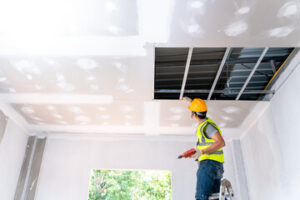Drywall is a building material that’s popular for many reasons. It’s inexpensive, easy to work with, and requires minimal maintenance.
However, installing drywall can be a complex task that takes specialized skills and equipment. It’s also a job that should be left to professionals if you want to get a good outcome. For professional help, contact Drywall Repair Las Vegas.
Drywall, or gypsum board, is an important material used to cover walls in houses and buildings. It consists of gypsum (calcium sulfate dehydrate) plaster compressed between sheets of heavy paper. The paper helps to maintain the board’s form so that it can be installed with screws and nails.
Before drywall installation, the walls must be clean, level and prepared properly so that the drywall is installed smoothly and accurately. This includes inspecting the site for any moisture damage, termites, loose blocking or other issues that can obstruct the drywall installation.
Once a surface is ready, the drywall panels are cut to size according to the measurements of the room. This requires careful measurements that include the dimensions of the walls, electrical outlets, light switches, ceiling fixtures and anything else that will need to be covered with drywall.
A professional will have the expertise to ensure that all of these things are included in the drywall panels. A good drywall installation will leave you with smooth, even walls that blend with the rest of your home’s interior.
If your drywall installation is not done correctly, you may end up with uneven and discolored walls and seams that are hard to cover. In addition, the drywall surface may not absorb paint evenly in all areas of the room.
Pre-filling the joints between drywall panels with hot mud, or joint compound, ensures that all the gaps and joints between drywall panels are covered. This step also prevents the drywall from shifting, which can lead to cracking and other issues.
Next, tape is applied to the walls in a variety of sizes to seal any gaps and to keep the drywall edges from becoming chipped or cracked. Tape is usually pressed into the mud in the joints and is then smoothed out with a roller to create a seamless finish.
The drywall installer then spreads a thin layer of joint compound, or drywall mud, into all the gaps and joints between drywall sheets. This step is repeated in the corners, so that the mud is thoroughly spread across the entire joint.
Drywall is a type of building material that is used for the interior walls and ceilings of residential buildings. It is a lightweight, inexpensive material that can be installed over a wide range of substrates, including wood framing, concrete slabs, and steel frames. It is easy to install and has a smooth, flat finish that’s durable and easily maintained.
When installing drywall, it’s important to know how to cut the material properly. It’s a good idea to learn how to use a saw so that you can cut the drywall in a way that is clean and accurate.
Whether you’re cutting out a window or making a hole for an electrical outlet, a drywall saw is the tool of choice. A drywall saw is much easier to hold and control than a circular saw, so it’s better for making precise cuts in drywall.
A drywall saw is also great for making a series of cuts in the same sheet of drywall, so you can easily create openings for windows, doors, or electrical boxes. It’s important to make these cuts from the front of the drywall, so you don’t rough up the paper on the face.
You should also take careful measurements before hanging the drywall. This is a critical step because if you measure incorrectly, you may have to repeat the process.
